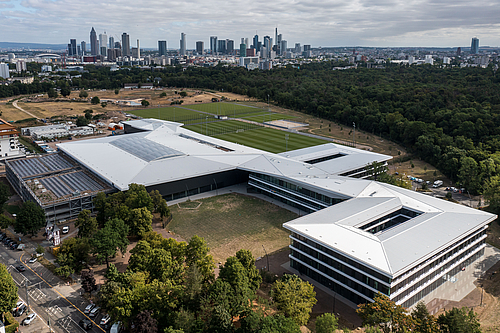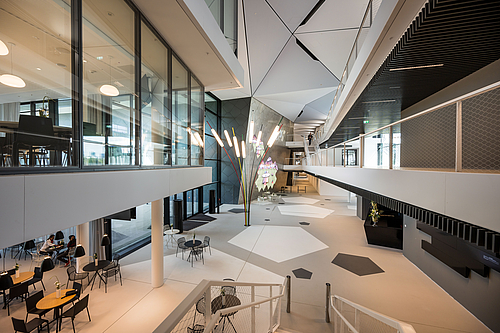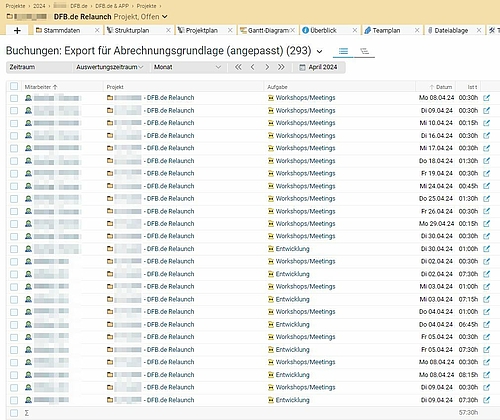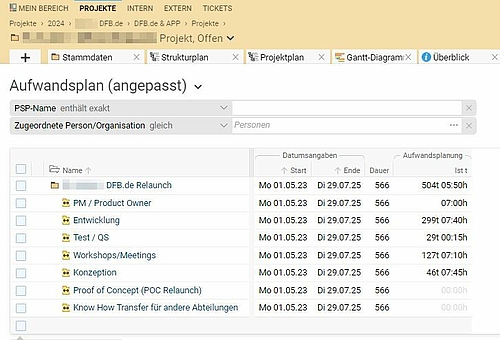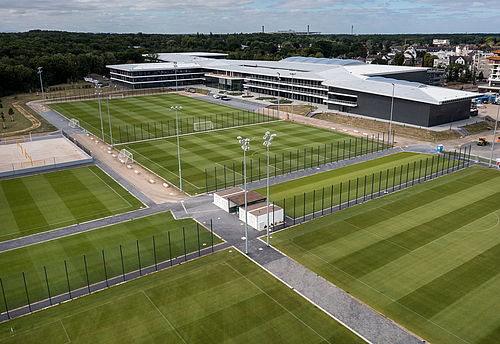Projektron BCS at the DFB: On the ball together since 2004
Success story from DFB GmbH & Co. KG
Working with project templates in Projektron BCS is super convenient, simple and very time-saving. I read through the documentation at the beginning and after ten minutes I was able to create a project template and create a project from it.
Was the win enough to climb to a promotion place? Did the competition slip up? Is it worth chilling the champagne because relegation is no longer an issue? Football is on the pitch. But not only. After all, how the season and matchday as a whole turn out has a lot more to do than just how your own team has done.
In professional football, sports programmes, apps and newspapers help you keep track of results and tables. But what if your own team is only playing in the district league? And even in the youth division? In the past, the table and the results of other teams were only published weeks later on the notice board or in the club newspaper.
In 2002, the German Football Association set about creating transparency in amateur football as well: The DFB founded a software and IT service provider for internal purposes as well as for the member associations. The company was to ensure that modernisation also found its way into DFB grassroots sport.
DFB GmbH & Co. KG - IT service provider for German football
DFB GmbH & Co. KG in Frankfurt am Main is part of the Deutsche Fußball-Bund e. V., the umbrella organisation of the DFL (German Football League) and five regional associations, divided into 21 regional associations in the Federal Republic of Germany.
It sees itself as an IT service provider for the subsidiaries, regional associations and umbrella organisations of the DFB. The employees look after the IT infrastructure on the DFB campus with over 500 workstations, media and conference rooms as well as professional measurement and analysis facilities.
DFB GmbH & Co. KG is an in-house IT service provider as well as an external service provider for the national associations. In the IT & Digital pillar, we provide internal support for the DFB's technical infrastructure as well as its in-house DFBnet software and all online portals, digital services and mobile applications. Externally, the DFB offers clubs all IT systems, such as accounting systems for clubs, systems for creating match schedules, for organising and structuring tournaments and for documenting and publishing results. We offer our services on a cost-covering basis in the interests of a club.
In addition, the IT & Digital division also provides its own applications and services, which are used by the DFB departments, the state and regional associations and the more than 25,000 clubs. Foremost among these is the development and operation of DFBnet and Fussball.de.
DFBnet and DFB.de are our media platforms. Fußball.de is also used by many media companies and is a very effective platform where all news and results are published. The main source of income is media-effective partner business with our sponsors, who place adverts on the banners at football matches or advertise with the DFB.
In addition, we maintain a DFBnet database for internal organisation, which records the results of amateur football matches and supports the promotion of young talent in particular. The database also contains medical data and helps to quickly identify potential young talent, right down to the smallest club.
We have a business model based on parity, i.e. the regional associations and clubs pay for our services, but are reimbursed part of the money in an incentive system if they submit their match results quickly and correctly.
In addition, there is also the electronic match report, i.e. the national and regional leagues can create their match reports online and enter facts such as the line-up, yellow and red cards, substitutions and goalscorers.
Since April 2022, I, Alexander Stoß, have been working at DFB GmbH & Co. KG as IT administrator for Projektron BCS and monitor the entire IT, i.e. all internal and external services. My main activity in BCS administration involves managing user accounts and projects. My job is also to create and control the projects in BCS, including material costs, resources and time expenditure.
IT projects for German football
DFB GmbH & Co. KG now has over 400 employees and numerous external service providers. Since the introduction of Projektron BCS in 2004, the number of BCS users has grown from 25 at that time to around 100 internal employees and 300 external employees today.
There are four departments within IT: The Project Management department deals with new projects, such as the SAP S4 implementation, and change projects. The DFBnet department deals exclusively with ongoing business with the regional associations. The Development department provides products and services that are newly developed for internal or external purposes. The IT Administration department operates the internal IT infrastructure such as company servers, company mobile phones and software applications.
The IT services within the DFB are organised entirely via BCS. Every year, we invest around 13,000 man-days in projects in the IT services area alone. Up to 150 projects with corresponding subtasks take place each year. This can no longer be mapped with MS Excel, but only with a professional software system.
Our projects are very different. We have small projects with a duration of two days and large projects with a duration of five years. We map all projects completely in Projektron BCS. Short projects involve minor changes, e.g. when a national association has changed its logo and it needs to be updated in the electronic match report. Including consulting, programming and uploading time for the new logo, such a project takes two staff days, i.e. 16 staff hours.
There are also ‘projects’ that are ongoing, i.e. permanent tasks with no fixed end date. Our biggest ‘projects’ are our media platforms such as Fussball.de. We also work to some extent using traditional project management methods, and in some cases agile with scrum methods.
Web-based project management organisation
DFB GmbH & Co. KG stands for modern working concepts: We work completely remotely. The project team members are not physically located in one place, but are spread across Germany. In use since 2004, Projektron BCS is now part of every DFBnet project and is primarily used for project planning and documentation.
The fact that Projektron BCS is web-based software was a decisive factor in the selection of project management software back in 2004. Data and documents can be accessed from anywhere, without problems with inaccessibility and parallel changes.
From project planning to acceptance
We use Projektron BCS primarily for project planning with subtasks, for which time recording takes place in the project flow, and for project documentation.
A typical project begins with an internal or external enquiry. For example, a national association wants a new function that it has seen at the Italian Football Association. The DFB assesses whether the function is feasible and whether it would add value for the other national associations. If this is the case, the project is approved. It is determined how much the project should cost, the maximum cost and the time required for implementation.
The project is then added to the project board and a project number (P number) is assigned. As the BCS administrator, I then create this project in Projektron BCS. Sub-tasks, the project manager and the rest of the project team are defined in consultation with the project managers. We define the team deployment plan and the schedule.
We use the contact management in BCS to inform the team members who is involved in which project. The comment function at all levels helps to document every detail and every good idea immediately. For the rest of the project communication, we use integrated Microsoft products such as MS Teams. We record the working hours for our project work to the minute in BCS.
We sometimes edit tasks in BCS during the course of the project, for example if the tasks take longer. We then finalise the project and put the project into a booking stop. We check that everything has been delivered and booked as described in the project. Then the project is finalised. During project sign-off, the project participants have to have their hours signed for invoice approval.
Compared to other software solutions, I find it very pleasant how easy user management is in Projektron BCS. It is very time-saving to create new users and provide them with a new password. Creating projects with templates is also one of my weekly tasks. Working with project templates in BCS is super convenient, simple and very time-saving. I read through the documentation at the beginning and after ten minutes I was able to create a project template and create a project from it.
Intuitive operation and good service
After internal training by a colleague, we took part in an introductory training course at Projektron lasting several days due to the great interest shown. We were shown what other possibilities and functions BCS offers. The training was very good, comprehensive and well structured. It was exciting for me to see what else BCS can do and how we could use BCS even more. I still use the documents from the workshop today when I have to do something new or want to correct errors.
Every month, we have an onboarding programme with up to ten new external employees who are brought in at project level. Half of them have already worked with Projektron BCS at other employers. For the other half, who are not yet familiar with the software, we have documented how to book tasks, how to book team plans, how to create time and effort plans, how to maintain the views and how to create exports in a wiki in Jira, approximately one A4 page with screenshots. This is very tangible, intuitively understandable and easy to implement for new employees. The effort required for time recording in particular is minimal for our external programmers.
Basically, the employees get on very well with Projektron BCS. People use the software intuitively and very rarely use it incorrectly. This is very positive for me as an administrator. The employees accept the system and are happy to use it because it works for everyone involved - whether internally, externally or for project acceptance.
We not only have service providers, but also temporary workers who have to book their working hours. Under the Temporary Employment Act, people have to book the start and end times of their work as well as the duration. For data protection reasons, the start and end times are not exported in the PDF in the weekly booking. As a controller, I have to export these times in order to validate whether the DFB fulfils its obligation to record these clock-in and clock-out bookings for temporary employees. Projektron support provided feedback on how this works within 24 hours.
Complex enough and yet intuitive
BCS is complex enough to map our entire projects in their level of detail and yet intuitive to use. I can say that BCS works very well and the users, end users, get on very well with it.
In the first few years after the introduction of BCS, our resource planning in particular has become easier. Projektron BCS helps us to recognise in good time whether we can meet our deadlines or whether the originally planned effort was calculated too tightly. There is feedback. You can learn a lot about the effort involved and incorporate this experience into the next projects.
At the same time, it is easy to recognise when one of the employees is overbooked out of euphoria for a new project, i.e. wants to do more work than they can realistically manage in the time available.
During my professional career, I have also had to deal with software where the maintenance effort required to look after the software was higher than with BCS. In terms of maintenance costs, i.e. the time required for the employee who maintains the software, Projektron BCS is very convenient.
We use Projektron BCS on a much too small scale. I know that BCS can do much more, because as an administrator I can see in the background what is possible. However, for reasons that are partly internal to the company, we can't use everything.
We recommend that other companies first implement a structure and then map it in Projektron BCS and not the other way round. It was only through the introduction of Projektron BCS that we realised that we needed a standardised structure and a common understanding of project management. We looked at what Projektron BCS offers as a tree structure and then modelled our own structure on it so that our structure could be mapped in BCS. We have also adopted this hierarchical structure from BCS in our other systems.
Synchronise software systems in the future
In order to facilitate the connection to other systems, we want to improve our interfaces in the future. We export the booked times from BCS as a CSV and synchronise these with the submitted service invoices in SAP. We want to connect these asynchronous systems in the future. This would make it easier to check whether a project's budget has been exceeded without manual exports. We are currently implementing SAP S4 and are planning a connection to Projektron BCS.
We also have a lot planned for the future in order to give the active footballers even more fun in their game and to offer the fans even more service. Projektron BCS, the project management software, will continue to help us achieve this.
